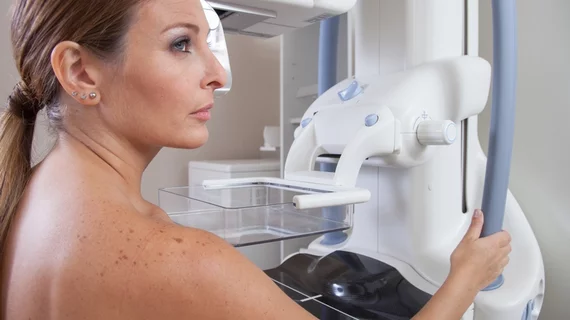Should patients undergo screening mammography after autologous breast reconstruction?
Screening mammography is a reasonable surveillance tool for breast cancer patients treated with mastectomy and breast reconstruction with autologous myocutaneous flaps (AMFs), according to new research published in Radiology. Mammography provides little additional value, however, if the patient had reconstruction after a prophylactic mastectomy.
The authors noted that “no established recommendation for routine imaging surveillance of autologous reconstructed breasts” with mammography, ultrasound or MRI presently exists. Their institution, however, has offered screening mammography for such patients since 2000.
For this study, data from 515 women who had undergone mammography of 618 AMFs between Jan. 1, 2000, and July 15, 2015, was retrospectively examined. All women had at least one year of clinical follow-up. Of the 618 AMFs, 78.5 percent were performed after mastectomy for cancer. The other 21.5 percent were performed after prophylactic mastectomy.
“Given the paucity of information in the literature, our goal was to examine how often screening mammography depicted clinically occult malignancy among women who had undergone breast reconstruction with AMF,” wrote lead author Mitra Noroozian, MD, from Michigan Medicine at the University of Michigan in Ann Arbor, and colleagues.
Overall, local-regional recurrence (LRR) occurred in 3.9 percent of patients. None occurred in women who had undergone prophylactic mastectomy. Sixty-five percent of patients with LRR were screened annually before their diagnosis. Fifty-four percent of those patients had clinically occult LRR.
The cancer detection rate (CDR) was 1.5 per 1,000 screening mammograms. Sensitivity was 42 percent, specificity was 99.4 percent, positive predictive value was 16 percent and false-positive biopsy rate was 0.6 percent.
“We demonstrated a low frequency of LRR in AMFs,” the authors wrote. “Screening mammography depicted small, clinically occult LRR without generating many false-positive biopsies. Given a CDR comparable to that of an age-matched woman, it may be reasonable to incorporate screening mammography as an adjunct surveillance tool for patients with breast cancer treated with mastectomy and autologous reconstruction. However, screening mammography added little value to the surveillance of women who undergo autologous reconstruction after prophylactic mastectomy.”
Noroozian and colleagues added that women with recurrences were young when initially diagnosed, but they “were unable to assess” whether age is truly predictive of LRR.

